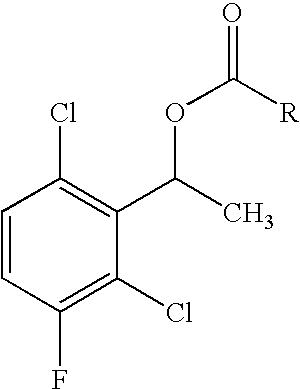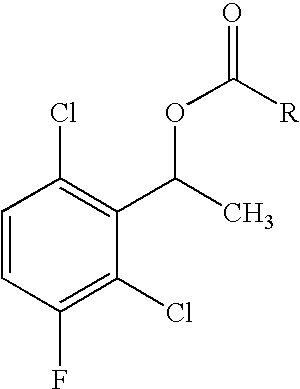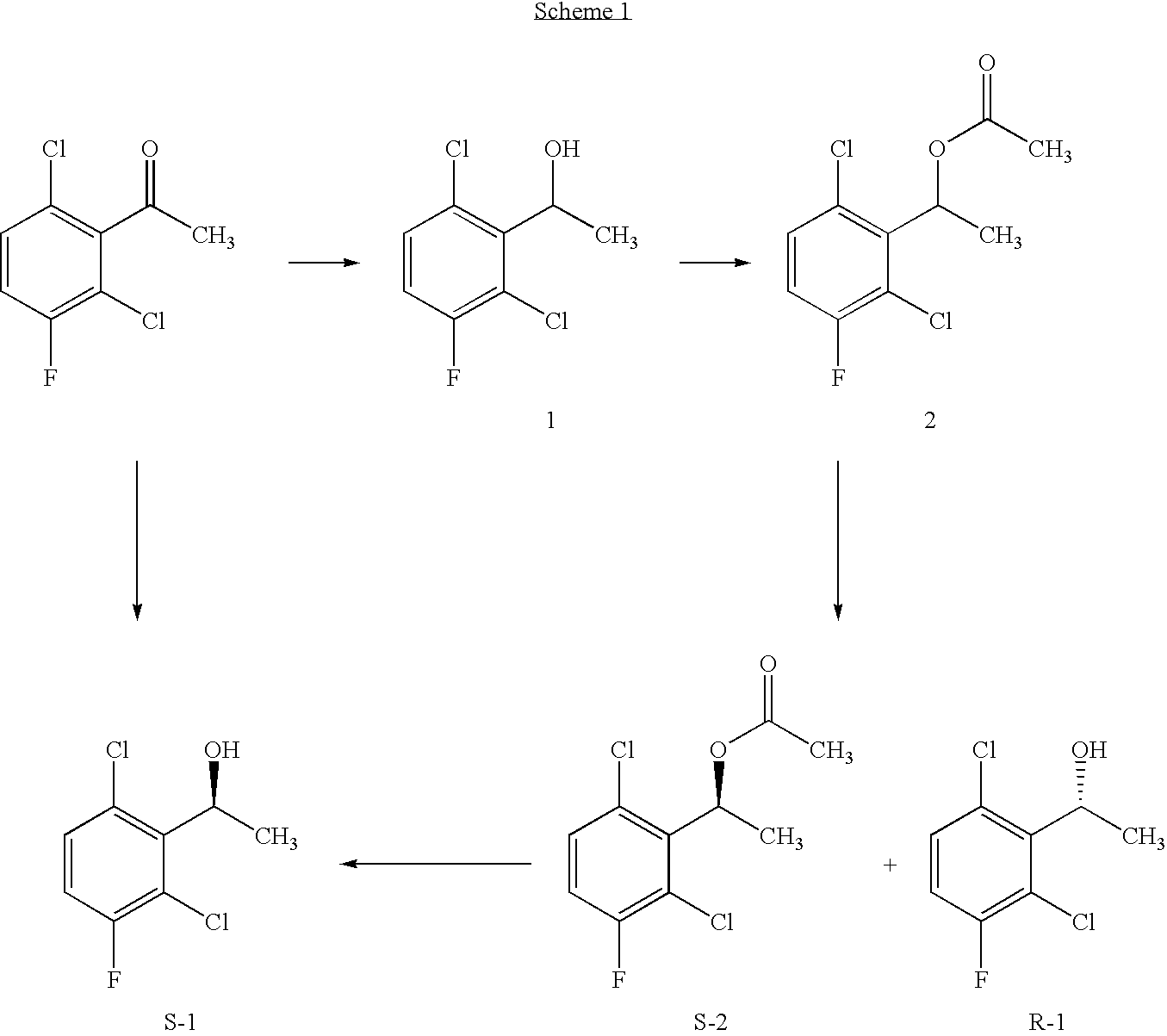Enantioselective biotransformation for preparation of protein tyrosine kinase inhibitor intermediates
a technology of enantioselective biotransformation and protein tyrosine kinase, which is applied in the preparation of halogenated hydrocarbons, organic chemistry, chemistry apparatus and processes, etc., can solve the problems of asymmetric synthesis that cannot be designed or prohibitively expensive, the synthesis and the mixture of enantiomers is difficult and often impossible to separa
- Summary
- Abstract
- Description
- Claims
- Application Information
AI Technical Summary
Benefits of technology
Problems solved by technology
Method used
Image
Examples
example 1
Preparation of Optically Active 1-(2,6-dichloro-3-fluorophenyl)ethanol by Combination of Enzymatic Resolution and Chemical Transformation
[0169] For illustrative purposes only, the process of the present invention is demonstrated by the following example of biotransformation of a racemic 1-(2,6-dichloro-3-fluorophenyl)ethyl acetate, which biotransformation is represented by Scheme 1.
Enzymatic resolution of 1-(2,6-dichloro-3-fluorophenyl)ethyl acetate (2)
[0170] The process involved performing four main steps: [0171] 1) preparing racemic 1-(2,6-dichloro-3-fluorophenyl)ethyl acetate [0172] 2) enzyme screening using commercially available lipases, proteases and esterases; [0173] 3) optimizing the reaction conditions such as pH, temperature and the amount of enzyme and substrate; and [0174] 4) maximizing yield of the enzymatic resolution method by developing a procedure for combination of enzymatic hydrolysis, esterification and chemical hydrolysis with inversion.
1) Preparing Racemic...
example 2
Enantioselective Bio-Reduction of 1-(2,6-dichloro-3-fluorophenyl)ethanone
[0208] The current process development was approached using whole cell catalyzed reactions as well as commercially available enzymes. The procedure involved performing three main steps: [0209] 1) screening of an internal whole cell (or isolated enzyme) collection containing mostly yeast and fungal strains (commercially available alcohol dehydrogenases and ketone reductases); [0210] 2) performing reaction optimization on pH, temperature and the amount of enzyme and substrate; [0211] 3) developing a procedure for the recycling of biocatalyst.
Whole Cell Screening
[0212] The screening for strains capable of doing the enantioselective reduction of 1-(2,6-dichloro-3-fluorophenyl)ethanone was carried out as follows. Microbial strains were grown from frozen stocks in a 96-well plate (5 μL / well). 200 μL of sterile YM media (Difco media 271120) was inoculated in each well. All strains were grown at 28° C. and 250 rpm ...
example 3
Use of (1S)-1-(2,6-Dichloro-3-Fluorophenyl)Ethanol in the Synthesis of Human Hepatocyte Growth Factor Receptor Tyrosine Kinase Inhibitors
[0224] (1S)-1-(2,6-dichloro-3-fluorophenyl)ethanol was used as an intermediate in chiral synthesis of human hepatocyte growth factor receptor tyrosine kinase inhibitors according to Scheme 8 and synthetic procedures described below.
[0225] Compound 3
3-[(1R)-1-(2,6-dichloro-3-fluorophenyl)ethoxy]-2-nitropyridine
[0226]
[0227] 3-Hydroxy-2-nitropyridine (175 mg, 1.21 mmol), triphenylphosphine (440 mg, 1.65 mmol) were added sequentially to a stirred solution of S-1 (229.8 mg, 1.1 mmol) in THF (10 mL) under a nitrogen atmosphere. The reaction mixture was maintained at room temperature for 1 h and then diisopropyl azo-dicarboxylate (0.34 mL, 1.65 mmol) was added at 0° C. The mixture was stirred for an additional 12 h. The reaction mixture was evaporated under vacuum to give an oil. The residue was purified by flash chromatography (eluting with 20→25% E...
PUM
| Property | Measurement | Unit |
|---|---|---|
| enantiomeric excess | aaaaa | aaaaa |
| temperature | aaaaa | aaaaa |
| optical purity | aaaaa | aaaaa |
Abstract
Description
Claims
Application Information
 Login to View More
Login to View More - R&D
- Intellectual Property
- Life Sciences
- Materials
- Tech Scout
- Unparalleled Data Quality
- Higher Quality Content
- 60% Fewer Hallucinations
Browse by: Latest US Patents, China's latest patents, Technical Efficacy Thesaurus, Application Domain, Technology Topic, Popular Technical Reports.
© 2025 PatSnap. All rights reserved.Legal|Privacy policy|Modern Slavery Act Transparency Statement|Sitemap|About US| Contact US: help@patsnap.com



